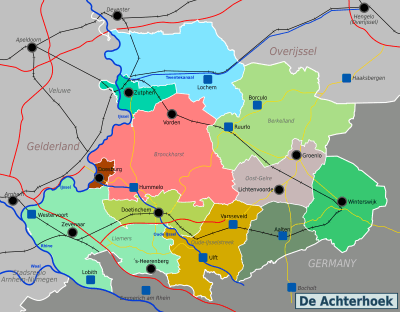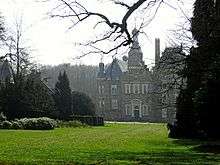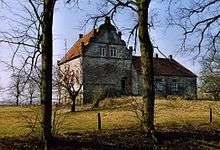Achterhoek
The Achterhoek is a region in the east of Gelderland (the Netherlands). The region is filled with untouched nature and a combination of farmland and astonishing landscapes. The Achterhoek is an area well-fitted for vacations by bike.
Cities

| Berkelland (Borculo, Beltrum, Eibergen, Neede, Ruurlo) A mix between the Achterhoek and Twente, featuring bocage, old wind and water mills and of course castles. |
| Bronckhorst (Hummelo, Keppel, Vorden) Municipality filled with castles. Vorden alone counts eight of them. Bronckhorst also features the smallest city of the Netherlands. |
| Doesburg Old Hansa city known for its mustard. |
| Doetinchem De facto capital of the Achterhoek. |
| Liemers ('s-Heerenberg, Lobith, Westervoort, Zevenaar) The region of water. Both the Meuse and Rhine flow through the region, as does the IJssel. |
| Lochem Old market and townhouse, scenic landscapes and lots of culture. |
| Oost Gelre (Groenlo, Lichtenvoorde) Municipality known most for its pilsner (Grolsch) and its large events. |
| Winterswijk Small city in the far east of the region. |
| Zutphen Known for its noble houses and fortifications. Due to its location in the northern tip of the Achterhoek, it is considered the 'Gateway to the Achterhoek'. |

Other destinations
- Bronkhorst - Smallest city in the Netherlands, counting about 157 citizens.
- 's-Heerenberg - Village most known for the Bergh castle.
Understand
History
As the Achterhoek never was a part of the Roman Empire, it, until Christianization around the year 800, was a region inhabited by Germanic tribes. The Achterhoek at this time was not a region of its own. The west of the region belonged to the Roman Catholic Archdiocese of Utrecht and the east to the Roman Catholic Diocese of Münster. The region would only come to exist as the Zutphen Country during Medieval times. The country encompassed many castles, many of which stand to this day, mostly owned by the royal families of Bronkhorst and Van Heeckeren, which fought several succession wars against each other. Until the 19th century the Achterhoek would be a feudal system.
Due to the region's location at the border, it has been invaded several times - mostly by German entities during the Guelders and Eighty Years War. Battles were mostly fought around the Bergh Castle and Keppel Castle, as well as the cities of Bredevoort and Groenlo. The latter of which re-enacts the 1627 Battle of Grolle bi-annually.
During industrialisation, a large part of the Achterhoek was still feudal. Many of the lands were still rough, existing of forests and sand flats. Industrialisation only had an effect on the cities along the Oude IJssel river and in the far east. Due to the ground here containing bog iron, a hype for metallurgy hit Doetinchem, Ulft and Keppel. Dutch brands here are ATAG, DRU and Pelgrim. In the east of the Achterhoek, textile industries were booming. Aalten, Neede and Winterswijk all took part until the end of the Second World War, when, due to competition from low-wage countries, the industry was no longer beneficial. During the time that it existed, the textile industry made large invests in the region. Especially Winterswijkse magnate Jan Willink funded many railroads that spanned throughout the region. This helped the textile industry survive in the rather remote east. Of these railroads, only the lines between Arnhem and Winterswijk and Winterswijk and Zutphen remain. Additionally, a heritage railroad, formerly spanning between Doetinchem and Hengelo (Overijssel) remains in function between Haaksbergen and Boekelo, both located just across the provincial border in Overijssel. These lines not only improved industry in the region, it did the same for tourism as well.
Since the start of the 21st century, many disappointing results made many companies end. The native pilsner brand Grosch, for one, had to leave the region to keep making a profit. Replacing it is a brand new wine industry, which nets betweek 20,000 and 40,000 bottles annually, depending on the season.
Geography
%2C_Woold%2C_Boven_Slinge_--_2014_--_3127.jpg)
The Achterhoek is compared to the Netherlands as a whole, rather thinly populated. Aside from the largely urbanised regions of Doetinchem, Winterswijk and Zutphen, large cities are nowhere to be found.
Some of the rough landscapes the region had during roman times are still around. Sand flats still exist near Doetinchem, and large forests are to be found in Montferland. Due to its both flat and slanted terrain, the region makes for a great cycling region for any sort of cyclist. All in all, the Achterhoek features large amounts of bocage. Highlights are the Lochemse Berg, the Ruurlo Woods and the Slangenburg. Some peatlands still exist near the German border.
Many castles are spread throughout the region with Vorden having a grand total of eight.
Traditions
Though the culture is considered to be a dying culture, parts of the Achterhoek still have traditions to their name. These include dauwtrappen on Ascension Day (getting up very early to go cycling), carbidschieten (filling a milk churn with carbide, putting a ball in the churn's opening and igniting it) and the consuption of Krumkake during new years. During Easter, many bonfires (Paasvuur) will be lit, and at the completion of buildings, the occasional maypole may be planted. Furthermore, local 'sports' include spiekerboksehangen, hanging a pair of jeans above a body of water, and testing can keep himself from falling in the water the longest. Typical to the east is noaberschap, literally translated the helping of neighbours, but in reality it comes down to general kindness.
Get in

From Amsterdam/Schiphol
To get to Zutphen or Winterswijk, take the Intercity train to Apeldoorn and change in Apeldoorn to the small diesel train connection Zutphen and Apeldoorn in 20 minutes. It leaves from Apeldoorn at --:10 and --:40, a few minutes after the Intercity from Amsterdam arrived. It usually departs from the opposite side of the platform. Alternatively, you can reach Zutphen via Arnhem by changing there, but it will take about 10 to 15 minutes longer; it doesn't cost more (i.e., with a ticket to or from Zutphen you can choose between the Apeldoorn and Arnhem routes). See the article on Zutphen for more extensive information. For Winterswijk, trains leave at --:07 and --:37, and depending on the route taken (Amsterdam-Apeldoorn-Zutphen) or (Amsterdam-Arnhem-Zutphen) will take between 135 and 153 minutes.
To get to Doetinchem, take the Intercity to Nijmegen and change trains in Arnhem. The train to Doetinchem and Winterswijk leaves 2 minutes after the arrival of the Intercity from Amsterdam, at --:04 and --:34, usually from platform 9. These trains take 34 minutes to Doetinchem and 68 minutes to Winterswijk, during the morning and afternoon rush there are 2 more to Doetinchem, at --:15, and --:45. For Winterswijk it's better to travel through Zutphen instead of Arnhem when coming from Amsterdam. To Doetinchem this should take 102 minutes, but it's likely to take 30 minutes longer because there's only a 2 minute change in Arnhem, which one is likely to miss.
Not all cities can be reached by train. The ones you can reach are:
Doetinchem, Zutphen, Winterswijk, Lochem, Vorden, Ruurlo and Aalten
From Germany

To get to eith of the cities above, head to Oberhausen (GER) first, whether that is by train or by car. When travelling by car, use the A3 in the direction of Arnhem, Utrecht or Amsterdam. To get to Doetinchem or Zutphen from here, leave the A3 the moment you cross the border. This should be Exit 30 - Beek. Join the N812 heading for Beek. At the end of the N812 you join the N335 heading for Didam. You then rejoin the highway (A18) in the direction of Doetinchem.
When travelling to Zutphen, take the route above, and leave the highway at Exit 3 - Doetinchem. Use the N316/N317 in the direction of Doetinchem. To not get stuck in traffic too much, use the N317 (Liemersweg) after crossing the rail line, and head right onto the Energieweg at the following traffic lights. Having crossed the river Oude IJssel, head left at the end of the Energieweg, onto the Keppelseweg, heading for Zutphen. Follow this road until you reach the roundabout after Langerak. There you take the first exit onto the N314. Having reached Hummelo, head left on the roundabout, and head in the direction of Zutphen from there. From here on the road will go directly to Zutphen.
Get around
The Achterhoek can be travelled by train, but having train stations servicing between Arnhem and Winterswijk via Zevenaar and Doetinchem, as well as Zutphen and Winterswijk via Vorden and Lievelde, using busses to get from A to B may be recommended. Busses are mostly serviced by Arriva, whereas trains are serviced by Breng as well. For planning your travel via public transport in general, 9292 can be recommended. Additionally, you could arrange a rental car or bike to get from A to B, as cycleways are well-maintained and of high quality.
See

%2C_Berenschot's_Watermolen_--_2014_--_3105.jpg)
- The Achterhoek is filled with Castles. Vorden alone has seven of them. Though not all of these castles can be visited, many of them are open to the public for a not too large entry fee. Must-sees include Kasteel Huis Bergh (Bergh Castle), located in 's-Heerenberg and Kasteel Keppel (Keppel Castle) in Laag Keppel
- Museums in the Achterhoek are mostly local, city museums. They often only display things that are of interest to locals wanting to know more about their city. Visiting these isn't a must, they may appeal to you. Moreover, the cities of Doetinchem and Winterswijk have the Openbaar Vervoer Museum and GOLS Museum, both of which highlight the role of public transport, especially trains and trams, for the region.
- Oost Gelre has several large events to its name, amongst which are De Zwarte Cross, which is held annually. It is the largest motocross event of Europe featuring not only motorised vehicles, but live music as well. Aside from that, Lichtenvoorde houses one of the largest flower parades of the Netherlands, if not Europe, called Bloemencorso Lichtenvoorde. It too is held annually.
- Beautiful landscapes are rather common in the Achterhoek, due to its semi-rural character. Terrains are flatter in the northwest of the region, and more slanted in the Montferland area in the south. The rivers going through the area have meandered a lot over time and have been straightened out over time. Their branches, now mostly lakes, as well as the rivers themselves too give beautiful photos. The Oude IJssel river around Keppel for one is beautiful during summer.
Do
- The Achterhoek is fit for hiking. Especially the well-forested area of Monferland is great for a long walk during summer of fall. The Pieterpad passes through the area as well. Every year a four-day hiking event is held somewhere in the month of May (for 2017; 24-27 May). The Achterhoekse Wandelvierdaagse usualy takes place in and around Doetinchem. Its routes are available online - though only in Dutch, if you'd rather walk alone.
- Cycling is the most common mode of transport amongst the Dutch, and the same goes for Achterhoekers. Routes are very varying, with the aforementioned Montferland area having off-road routes with terrain that's varying in height. The further from the German border you are, the more flat the terrain is. You can easily go from one town or city to another within half a day, so a vactaion by bike is a perfect option.
- Recreational waters are a popular getaway for locals. Many former sand mining operations have been flooded by man to create lakes and many of them have been transformed to recreational lakes. The Liemers alone has three of these. Another one can been found just south of Zutphen.
- Canoeing or Kayaking can't be done on many rivers due to them being used for transport by fright ships. The Oude IJssel river, however, is perfectly fit for this activity. Routes start in Doetinchem or somewhat more upstream near Terborg, and end in Doesburg.
Talk

All of the Achterhoek speaks Dutch, in more rural areas people may speak the local dialect, Achterhooks, which is part of Low German. Within the cities many people will be able to speak to you in English, especially the younger generations. Aside from English, many people will be able to understand German.
Eat

- The Achterhoek does not have many local products to its name, but the city of Doesburg does have its own mustard, which, if you like mustard, you should definitely try.
Drink
Go next
If the Achterhoek is one of the first regions of the Netherlands you visit, then you can easily go further north in the direction of Twente, Overijssel, Drenthe, Groningen and Friesland.
You could also head south in the direction of North Brabant, Limburg and Zeeland.
If you're more into citytrips, then head west in the direction of the Randstad, to the provinces of North- and South-Holland or Utrecht.
| Routes through Achterhoek |
| The Hague ← Utrecht ← Arnhem ← | W |
→ Osnabrück |
| A12 ← | W |
→ Doetinchem → N18 |
| A18 ← Varsseveld ← | W |
→ Groenlo → Enschede |
| Deventer ← | N |
→ Zutphen → Doetinchem (Via N314) |
| Arnhem ← Zevenaar ← | W |
→ Doetinchem → Winterswijk |
| Zutphen ← Vorden ← | W |
→ Ruurlo → Winterswijk |